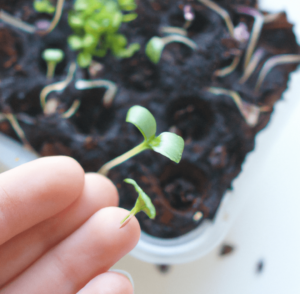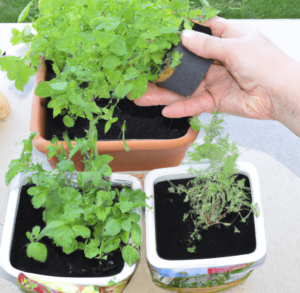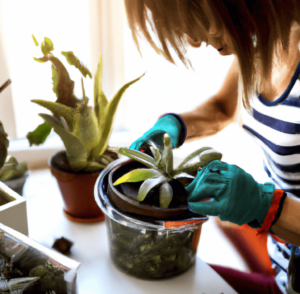Lasagna gardening is a type of gardening that involves creating a garden bed by layering materials on top of the ground. This method of gardening is also known as sheet composting, and it is a great way to create a healthy and productive garden with minimal effort.
Gardening is a popular hobby that allows people to grow their own fruits, vegetables, and herbs. It can be a relaxing and fulfilling way to spend time outdoors, and it can also provide fresh, healthy food for your family. However, traditional gardening can require a lot of work, such as tilling the ground, preparing the soil, and watering the plants.
Lasagna gardening is a different approach that eliminates the need for tilling and other labor-intensive tasks. Instead, you create a garden bed by layering materials on top of the ground, and the layers decompose over time to create a rich, fertile soil. This method is called lasagna gardening because the layers of materials resemble the layers of a lasagna.

Here is How to Create a Lasagna Garden Bed
- Start by choosing a location for your garden bed. It should be in a sunny area with good drainage.
- Next, mark out the shape and size of your garden bed. You can use string or stakes to create a border around the bed.
- Begin layering materials on top of the ground. Start with a layer of brown materials, such as leaves, straw, or shredded newspaper. This layer will provide carbon for the decomposing process.
- Add a layer of green materials, such as grass clippings, food waste, or coffee grounds. This layer will provide nitrogen for the decomposing process.
- Continue layering materials in this way until your garden bed is about 12 inches deep. Make sure to water each layer as you go to help the materials break down.
- Once your garden bed is complete, you can plant your seeds or seedlings directly into the soil. The plants will grow and thrive in the rich, nutritious soil created by the layers of materials.
Lasagna gardening is a simple and effective way to create a garden bed without the need for tilling or other labor-intensive tasks. It is a great option for anyone who wants to start a garden, but doesn’t have the time or energy for traditional gardening methods. Give it a try, and see how easy and rewarding lasagna gardening can be.
Lasagna Gardening
Lasagna gardening is a method of gardening that involves layering organic materials on top of the ground to create a new garden bed. This method is often used by gardeners who want to create a garden without having to till or disturb the existing soil.
To create a lasagna garden, you will need a variety of organic materials, such as leaves, compost, grass clippings, and manure. These materials are layered on top of the ground in a specific order to create a rich, fertile bed for your plants to grow in.
The benefits of lasagna gardening include improved soil structure and fertility, as well as reduced weed growth and water usage. Additionally, because the materials used are organic, they will break down over time and add valuable nutrients to the soil.
To get started with lasagna gardening, simply gather your materials and begin layering them on top of the ground in your desired garden location. Be sure to water your garden regularly and add additional layers of organic materials as needed to maintain its fertility and structure. With a little time and effort, your lasagna garden will thrive and provide you with a bountiful harvest of fresh fruits and vegetables.
Pros & Cons of Lasagna Gardening
Lasagna gardening is a method of building a garden bed without having to dig or till the soil. This approach has both advantages and disadvantages when compared to traditional gardening methods.
Pros:
- Lasagna gardening allows for quick and easy setup of a garden bed.
- Because it does not involve digging or tilling, lasagna gardening can be a less labor-intensive way to create a garden bed.
- Lasagna gardening can be a great option for people with physical limitations who may have difficulty with traditional gardening techniques.
- This method can be used in areas where the soil is compacted or difficult to work with.
- Lasagna gardening can help improve the soil structure and increase its fertility over time.
Cons:
- Because it does not involve digging or tilling, lasagna gardening may not be as effective at controlling weeds as traditional gardening methods.
- This method may not be suitable for all types of plants, as some plants may not thrive in the lasagna gardening environment.
- Lasagna gardening may not be as effective at controlling pests and diseases as traditional gardening methods.
- This method may require more frequent watering than traditional gardening methods.
- Lasagna gardening may not be as effective at providing adequate drainage for plants as traditional gardening methods.
Layers in Organic Gardening
In organic gardening, the use of layers can be an effective way to manage green, growing organic materials in the yard. By building layers of organic materials, such as yard waste and fertilizer, gardeners can create a rich and fertile environment for plants to thrive.
The process of layering involves adding alternating layers of wet and dry materials, such as grass clippings, leaves, and compost, to create a compost pile or bin. As the materials break down, they release valuable nutrients and moisture, creating a natural fertilizer for plants.
Layering can also be used to improve the soil in garden beds. By adding layers of compost, mulch, and other organic materials on top of the soil, gardeners can improve the soil’s structure and fertility, leading to healthier plants and better yields.
Overall, the use of layers in organic gardening is a sustainable and effective way to manage green, growing materials and create a rich and fertile environment for plants to thrive.

Gardening Bed
A bed is an area of land used for gardening or other types of plant cultivation. The bed is typically framed by edges or borders, which can be made of wood, stone, or other materials. The bed is filled with soil or other growing media, such as compost, to support the growth of plants.
Gardening is the practice of growing and cultivating plants, typically in a backyard or other outdoor space. Gardening can be a relaxing and enjoyable hobby, and can also provide fresh fruits, vegetables, and herbs for consumption.
Sheet composting, also known as lasagna gardening, is a technique used in gardening to create a bed of organic materials that will break down over time and enrich the soil. Sheet composting involves layering materials such as leaves, grass clippings, and other organic matter in a bed, and allowing them to decompose naturally. This can be an effective and environmentally-friendly way to improve the soil in a bed.
In summary, a bed is an area of land used for gardening, typically framed by borders and filled with soil or other growing media. Gardening and sheet composting are practices that can be used to cultivate plants and improve the soil in a bed.
Materials
One of the key materials used in gardening is the ground itself. Whether you have a traditional garden bed or are using a technique like Lasagna gardening, the soil will play a crucial role in the health and growth of your plants.
Another important material is compost. A compost pile is a great way to recycle yard waste, such as leaves, and turn it into a nutrient-rich soil amendment. Adding compost to your garden can help improve the structure and fertility of the soil, which can in turn lead to healthier plants.
Leaves can also be used in a number of ways in the garden. In addition to being added to a compost pile, they can be used as a mulch to help retain moisture in the soil and suppress weeds. Some gardeners even use leaves to create a “lasagna” layer in their garden beds, which can help improve the soil without the need for tilling.
Overall, there are many materials that can be used in the garden to help plants grow and thrive. From the ground itself to compost and leaves, each material can play a vital role in the success of your garden.
Bottom Line: Lasagna Gardening is Known for its Layering Organic Materials on Top of the Soil
Lasagna gardening, also known as sheet mulching or sheet composting, is a method of creating a garden bed by layering organic materials on top of the soil. The layers, or “lasagna,” can include things like cardboard, newspaper, grass clippings, leaves, and compost. This method of gardening allows gardeners to create a new bed without having to till the soil or remove existing vegetation, which can be beneficial for soil health and the environment. Lasagna gardening is a low-maintenance method of gardening that can be used to grow a variety of plants, including vegetables, herbs, and flowers. It is a good choice for gardeners who want to create a new bed quickly and easily, or who want to avoid disturbing the soil.
If you’re interested in lasagna gardening, you may also be interested in keyhole gardening and mittleider gardening.







